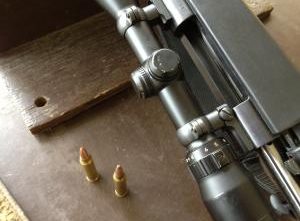The ABCs of Riflescopes
Riflescopes form a critical part of shooting equipment used by most firearm enthusiasts especially for sporting and hunting purposes. It is an optical sighting device that greatly simplifies the complexity of lining up conventional iron sights on a firearm, which required the shooter to line up the rear and the front sight with the target. Using a riflescope, the shooter simply lines up the reticle or crosshairs with the target aiming through the scope. As most riflescopes also increase magnification the target appears clearer and closer to let a precise shot be placed. For people of advanced age it usually becomes difficult to switch their focus from a rear sight to a front sight when using iron sights. With a riflescope, this frustration is eliminated letting them adjust ocular focus to suit their eyes for a crisp and clear target picture.
There are countless models of riflescopes available from reputable optical equipment manufacturers. Alpen, ATN, Burris, Bushnell, Leupold, Nikon, Pentax, Schmidt Bender, Sightron, Swarovski, Yukon, Zeiss are some of the many brands from among which a selection for a good riflescope can be made. Numerous models are offered by each manufacturer and a ‘good riflescope’ would really depend on the specifications of the unit to suit individual needs and preferences of a user as what may seem good to one may not necessarily appear to be so to another.
Riflescopes are available in different powers. Power refers to the magnification over and above normal human eyesight afforded by the scope. Normal human eyesight is expressed as 1x magnification. This means that a scope with a power of 6x will make a target appear 6 times larger than its actual size. Riflescopes are either fixed magnification scopes or variable magnification/zoom powered scopes. For example 3x, 6x and 9x riflescopes will provide fixed magnification of actual target size by 3, 6, 9 times respectively whereas a 3-9 riflescope will be a variable type and will be able to magnify target size by anywhere between 3 to 9 times depending on adjustments made to it.
When a riflescope is identified as being a 3-9×40, it means it is capable of variable magnification of 3 to 9 times and is equipped with a 40 mm objective lens. 3x 30 indicates a 3 times fixed magnification riflescope having a 30mm objective lens. The objective lens is one that is located at the front of the scope with the lens nearer to the eye being called the ocular lens. Generally speaking an objective lens of a larger diameter will permit more light to enter the scope as compared to one with a relatively smaller diameter. This caters to better viewing under poor light conditions. A 55mm scope will have a 55mm objective lens. However, to accommodate a scope with a larger sized objective lens the user needs to be mount the scope higher on the barrel that imposes a serious limitation to the comfort and ease of eye alignment and a repeatable stock weld. A stock weld is a firm and comfortable repeatable position of a shooter’s face on the gun/riflestock.
A good quality riflescope will be fog and waterproof and will have coated lenses. Lens coatings are not cheap and increase the overall cost of the scope. Lenses are coated in order to minimize glare and loss of light due to reflection. Available light is transmitted through the lenses to the eye of the user with some amount being lost in the process. The average scope transmits approximately 90 percent of the light and any scope that is able to transmit over 95 percent is said to be excellent. Lenses can be single coated or multicoated. The terms used for identifying coated riflescope lenses refer to
- ‘coated’ meaning a single layered coating on at least one surface of each lens,
- ‘fully coated’ meaning a single layered coating on all glass surfaced exposed to air
- ‘multicoated’ meaning multiple layered coatings on at least one surface of each lens
- ‘fully multicoated’ meaning multiple layered coatings on all lens surfaces exposed to air.
Lenses with more number of coatings provide better light transmission and sharper contrast.



